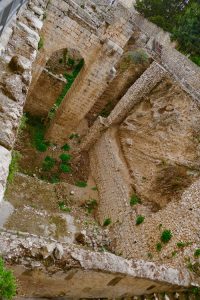HOMILY LENT WEEK 04 02 – Year II
Plunge into the Healing Waters of God’s Grace
(Ezk 47:1-9, 12; Ps 46; Jn 5:1-6)
***********************************************
Four times a week, I am in a swimming pool for a half-hour aquacize session. That practice not only provides health benefits for me, but also deepens my appreciation for the blessings of water.
Today’s readings invite us to believe in Jesus as the new temple, plunge into the flowing waters of God’s grace, experience his forgiveness and healing, and become a river of God’s grace to all others.
Water is composed of two hydrogen atoms and one oxygen atom – so simple yet so pervasive and such an essential part of creation and our lives. Apparently, sixty percent of our body is made up of water. Scientists are always searching for signs of water in the universe, while we enjoy water’s amazing use for recreation, refreshing, renewing, cleansing, even destroying.
No wonder our creator God used the vision of a flowing stream of life-giving water given to the prophet Ezekiel to teach humanity the nature of God’s loving grace and the role of genuine religion. That ever-flowing and ever-growing stream from the temple to the Arabah freshens, nourishes, promotes life and provides healing. That stream represents God’s desire to give us forgiveness of our sins, and healing of our defects of character.
The fact that this stream flows out from the altar and under the threshold of the temple signifies that the role of institutional religion was to channel God’s grace, God’s unconditional love, God’s forgiveness and healing to the people of God, to the poor and those most in need.

Bethesda pool
There is an obvious link between the flowing stream in the first reading with the healing waters of the Pool of Bethzatha near the Sheep Gate of the Temple Mount in Jerusalem. Having been there, it is easy to imagine Jesus encountering the man who was an invalid for thirty-eight years, even though the five porticoes are empty and dry today.
The fact that the invalid could not get to the water on time, that someone else always got there before him (for thirty-eight years) when it was stirred up should alert us that something was not right about the religious system as it had developed. Those most in need were powerless to help themselves and there was no one there to help them.
Somehow, over time, between the vision of Ezekiel and the time of Jesus, a systemic lack of caring and of compassion must have crept into the religious system of Judaism as it was practiced by the religious leaders. The Jewish leaders, caught up in their legalism and love of possessions, prestige and power, missed the opportunity to receive healing themselves, and were complicit in not providing it for the poorest among them.
Then, the fact that the man was healed, not by the stirring waters but by simply obeying the Word of Jesus to take up his mat and walk, reveals that Jesus had greater power to heal than the water, and would do so with much greater compassion. The Word of Jesus itself becomes living water for the sick man.
The fact that Jesus sought out the man who was healed, as he sought out the man born blind previously, highlights the amazing particular love of our God in Jesus Christ for each one of us. The creator of the universe calls each one of us by name, as he did for Lazarus and for Mary Magdalene. He wants to heal each one of us in any particular way we may need healing. How astounding is that?
Also, the fact that Jesus actually commanded the invalid to do something that broke the Sabbath law reveals that in Jesus, there was greater authority then the set of religious rules and regulations developed out of the Old Testament era. Jesus was putting the law of love over and above the laws of religion, showing that those laws were to serve, not subjugate, humanity.
There are other important implications for us in these readings. First of all, note that the invitation is to not just observe but to wade right into the water, so we are invited to plunge into the waters of God’s grace. Second, that water is a source of strength, growth, healing and joy for us, no matter what circumstances or tribulations make up the riverbank of our lives.
Third, we are to come to Jesus not only for freshening and cleansing, for the forgiveness of our sins, but also for healing of our painful emotions such as anger and resentment, our negative attitudes such as false pride, stubborn self-will and self-sufficiency (attitudes that the Pharisees, chief priests, scribes and religious leaders displayed in spades), and even our addictions.
That answers the question of the Pharisees – “Who is this man?” and allows Jesus to be who he wants to be for us – savior, Lord, redeemer, sanctifier, the long-awaited Messiah, and the new temple, the new presence of God among God’s people. The blood and water flowing from his side on the cross is the divine, eternal life he wants to share with us, his body, the church. The church in turn is not to be a reservoir trying to control God’s grace like the Pharisees, but to be a great river from which God’s love, compassion, forgiveness and healing will flow out to all nations.
The Eucharist is an experience of wading right into the flowing waters of God’s grace, of forgiveness and healing through word and sacrament, here and now.
So, let us place our faith in Jesus as the new temple, plunge into the flowing waters of God’s grace, experience his forgiveness and healing, and become a river of God’s grace to all others, as the church.



